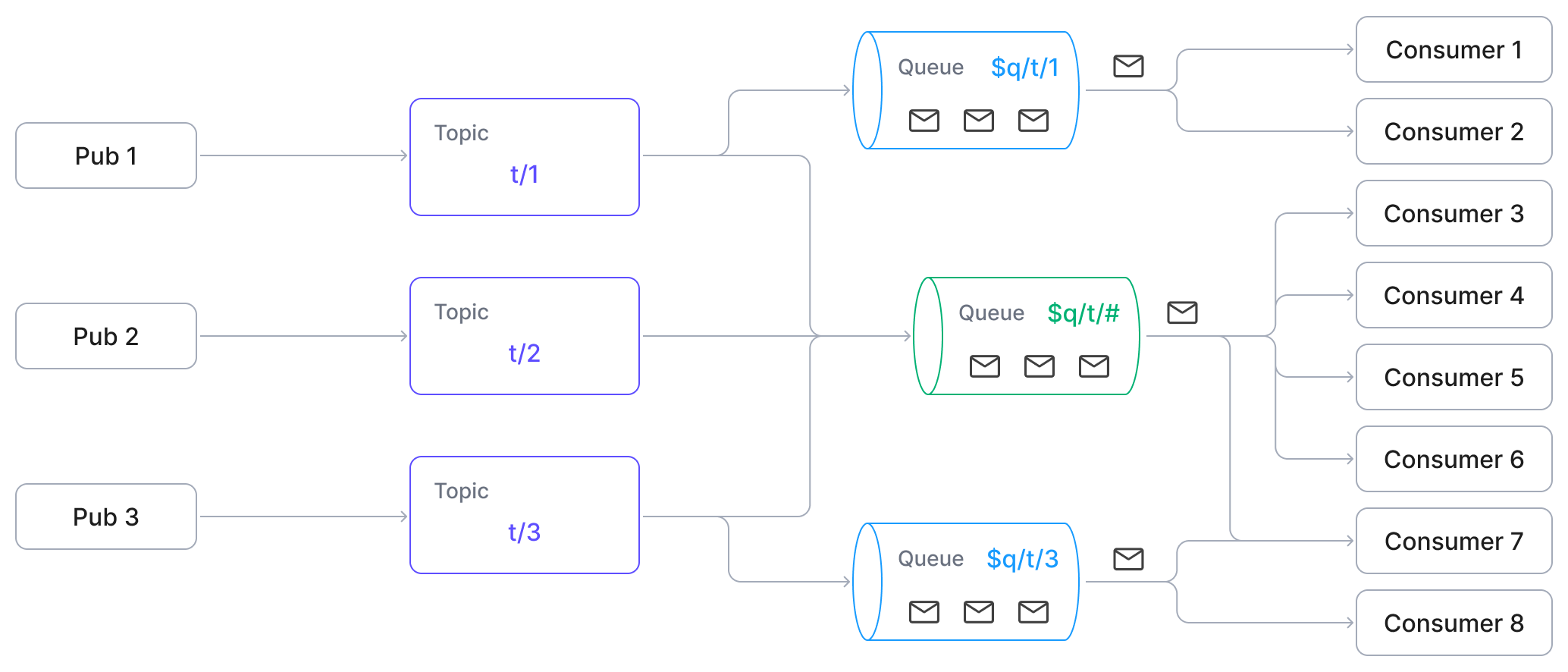New Features
This page highlights major new features supported in the current release. Note that it does not list every feature provided by EMQX.
EMQX 6.0.0 (Latest)
Message Queue
Message Queue unifies reliable, real-time MQTT publish/subscribe with asynchronous message queuing within EMQX, eliminating the need for external queuing services.
Unlike traditional MQTT, which depends on subscriber availability, Message Queues decouple publishers and subscribers by buffering messages on the server. Messages matching a specified topic filter are stored persistently and can be consumed later using a special topic format: $q/{topic_filter}. This ensures reliable message delivery, even when clients are offline or the network is unstable.

This feature enables MQTT to handle both real-time and delayed workloads, simplifying IoT system architecture by removing the need for external queuing systems like Kafka or RabbitMQ. It’s ideal for scenarios where message durability, reliable delivery, and offline buffering are critical.
Feature Highlights
- Unified Messaging Model: Combines lightweight MQTT with enterprise-grade queuing in a single system.
- Offline Storage: Messages are retained even when subscribers are disconnected.
- Last-Value Retention: Optionally keep only the latest message per key (e.g., device ID), perfect for fast-changing data like sensor readings.
- Flexible Dispatch Strategies: Choose from Random, Round Robin, or Least Inflight Subscriber to distribute messages efficiently.
- Guaranteed Delivery: Supports persistent storage and QoS 1 delivery to ensure no data is lost.
Learn more in the Message Queue documentation.
Multi-Tenancy with Namespaced Roles
EMQX 6.0.0 introduces namespaced roles to enhance multi-tenancy and access control across large-scale IoT deployments. With this feature, users are assigned to specific namespaces, isolated environments where they can manage their own resources such as Rules, Connectors, and Actions, without accessing or impacting other tenants.
Namespaced roles support fine-grained permissions such as Administrator and Viewer, and can be managed through the Dashboard, API, or CLI, making it easier to delegate responsibilities while ensuring secure isolation between teams, departments, or customers.
Feature Highlights
- Secure Isolation: Users can only access and manage resources within their assigned namespace (e.g.,
ns:team_a::administrator). - Granular Access Control: Namespaced users have full access to namespace-specific resources, but cluster-level settings remain read-only unless granted global admin rights.
- Simplified Operations: Roles can be created and assigned easily during user creation.
- Scalability for Enterprises: Ideal for organizations offering multi-tenant MQTT services or managing internal business units with separate responsibilities.
Additional Enhancements
- Improved Observability: Dashboard views are filtered by namespace for better focus.
- Optimized Session Tracking: Namespaced session counts now refresh on demand (under 1,000 sessions) or every 5 seconds otherwise, ensuring better performance and accuracy.
For detailed instructions, see Create a User with a Namespaced Role.
Optimized Durable Storage
EMQX 6.0.0 delivers significant improvements to durable storage, enhancing performance and scalability for high-throughput IoT workloads. By decoupling session data from other broker metadata, EMQX now consumes less RAM and achieves better storage efficiency, allowing more connections per node.
Optimized RocksDB Parameters
New configuration options give precise control over memory and performance:
durable_storage.messages.rocksdb.write_buffer_size: Controls per-shard memtable size.durable_storage.messages.rocksdb.cache_size: Sets block cache size per shard.durable_storage.messages.rocksdb.max_open_files: Limits file descriptors per shard.durable_storage.messages.layout.wildcard_thresholds: Optimizes wildcard handling in storage layout.
Additional Enhancements
- Efficient Serialization: The default serialization format has changed to ASN.1, reducing storage size and improving processing speed.
- Faster Access & Lower Overhead: Improved storage layout leads to quicker message retrieval and reduced disk and memory overhead.
These enhancements make EMQX more capable of handling large-scale, persistent MQTT workloads with consistent performance.
Expanded Support in Data Integration
EMQX 6.0.0 continues to strengthen its data integration capabilities, empowering users to seamlessly connect MQTT data with modern cloud and database ecosystems for real-time analytics, processing, and storage.
New Integrations
The following integrations have been newly added in EMQX 6.0.0:
- Google BigQuery: Integrate MQTT data with BigQuery for large-scale data warehousing and advanced querying, enabling insights from massive IoT datasets.
- AWS AlloyDB, CockroachDB, and AWS Redshift: Stream MQTT data to these high-performance databases for real-time analytics and scalable storage. Perfect for enterprise-grade IoT analytics.
Enhanced Integrations
In addition to new integrations, EMQX 6.0.0 brings powerful enhancements to existing integrations, improving performance, usability, and cloud-native compatibility:
- Snowflake Snowpipe Streaming: Now supports low-latency data ingestion into Snowflake tables via Snowpipe Streaming (preview feature of Snowflake), available for AWS-hosted accounts.
- RocketMQ Action: Adds support for
keyandtagtemplates, plus akey_dispatchstrategy for flexible message routing and metadata enrichment. - AWS S3 and AWS S3 Tables Connector:
access_key_idandsecret_access_keyare now optional, with automatic retrieval from EC2 Instance Metadata Service v2 APIs in AWS-hosted environments. - RabbitMQ Sink: Allows customization of Headers and Properties Templates to enhance message routing and compatibility within RabbitMQ.
Other Enhancements
Advanced LLM-Based MQTT Data Processing
EMQX 6.0.0 enhances LLM-based data processing with support for Google Gemini models, alongside OpenAI and Anthropic Claude.
Enhanced LDAP Support
LDAP authorization now supports extended ACL rules in JSON format, and LDAP authentication can fetch ACL rules directly from LDAP with client-side caching.
Improved Tracing
Configurable limits for maximum traces (trace.max_traces) and trace file sizes (trace.max_file_size). After max_file_size is reached, the trace log will rotate to a new file instead of halting.
Cluster Management
New cluster.description configuration option allows users to set and display custom cluster descriptions in the EMQX Dashboard. For how to add the cluster description on the Dashboard, see Dashboard -> Management -> Cluster Settings.
More Features
In addition to the highlights covered above, recent EMQX updates include many other new features and enhancements. For a complete list, see the Release Notes.
Breaking Changes
For complete information about what's deprecated and breaking changes, see Incompatible Changes between EMQX 5.x and EMQX 6.0.
EMQX 5.x Series
For a complete list of features and updates in EMQX 5.x, please refer to: EMQX 5.10 Documentation – What's New.